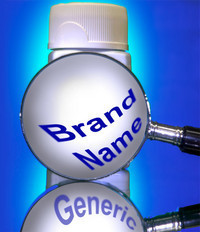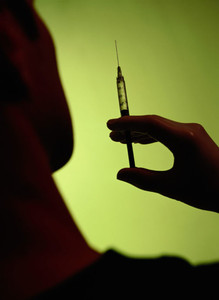Is there a benefit to prescribing brand-name drugs versus prescribing generics? The answer appears to be no, according to evidence collected by researchers from the University of British Columbia in Vancouver and the University of Alberta in Edmonton, Canada [1].
The evidence that lead the researchers to this conclusion includes bioequivalence data and the outcomes of clinical trials comparing brand-name and generic drugs.
Bioequivalence
Regulators require evidence of average bioequivalence in drug absorption in terms of pharmacokinetic (PK) parameters be provided through the conduct of bioequivalence studies. This may be done using the area under the blood and/or plasma concentration-time curve (AUC) and peak concentration (Cmax) [2].
In practice, it may be claimed that a generic drug is bioequivalent to an originator (reference) drug if the 90% confidence interval (CI) for the ratio of geometric means of the primary PK parameter is completely within the bioequivalence limits (80−125%). The Canadian researchers point out that this means that the absolute differences in bioequivalence must be no more than about 5−7%.
Between 1996 and 2007, 2,070 single-dose bioequivalence studies showed the average differences in Cmax and AUC were 4.35% and 3.56%, respectively. Overall, 98% of studies showed the AUCs of generics and originator products differed by less than 10%.
Clinical outcomes
A systematic review, which included 38 trials, of cardiovascular medications, carried out by Kesselheim and co-authors [3], found clinical equivalence in 35 of 38 trials. While a systematic review of warfarin [4] found no statistically significant difference in international normalized ratio or dosage changes required in five trials (higher level evidence) found. Although in the same review six observational studies (lower level evidence) showed inconsistent results at higher risk of bias.
The authors pointed out that there are often negative views about generics. This was evidenced by the fact that of 43 editorials on generic medication issues, 23 (53%) expressed negative views about generic substitution, despite the fact that only 8% of trials found any difference in any outcome.
Although McCormack and Chmelicek state that ‘generic and brand-name medications produce similar clinical outcomes, they also point out that differences in shape, colour, taste and name can lead to patient, and sometimes clinician, confusion. These differences have been associated with lack of patient adherence to their medication [5, 6]. In fact, the US Food and Drug Administration (FDA) announced in October 2014 that it would carry out a survey into the effect of the shape, colour and size of generics from different manufacturers and how this affects patient adherence to their medication [7].
The authors also point out that generics can contain different fillers and rarely some patients might not tolerate the medication for that reason. Fillers and diluents add bulk to products making very small active components easy for the patient to take. Examples include lactose, sucrose, magnesium stearate, glucose, plant cellulose, calcium carbonate. Magnesium stearate has been found in some studies to suppress immune function, while lactose can cause severe gastro-intestinal upset in individuals sensitive to milk products [8].
As a result of their research into brand-name and generic drugs the authors conclude that ‘according to the best available evidence, generic medications are bioequivalent and produce similar clinical outcomes to brand-name medications.’
Conflict of interest
The authors of the research paper [1] did not declare any conflicts of interest. They stated that the opinions expressed in their article are those of the authors and do not necessarily mirror the perspective and policy of the Alberta College of Family Physicians.
Editor’s comment
Readers interested to learn more about perceptions towards generics and patient adherence to generic medicines are invited to visit www.gabi-journal.net to view the following manuscripts published in GaBI Journal:
Perceptions of physicians from private medical centres in Malaysia about generic medicine usage: a qualitative study
Role of hospital clinical pharmacist in transplantation, and generic immunosuppressive therapies
Readers interested in contributing a research or perspective paper to GaBI Journal – an independent, peer reviewed academic journal – please send us your submission here.
Related article
Irish pharmacists’ perceptions and attitudes towards generics
Factors important for generics substitution in Finland
References
1. McCormack J, Chmelicek JT. Generic versus brand name: the other drug war. Can Fam Physician. 2014;60(10):911.
2. GaBI Online - Generics and Biosimilars Initiative. Quantitative evaluation of bioequivalence [www.gabionline.net]. Mol, Belgium: Pro Pharma Communications International; [cited 2015 Feb 6]. Available from: www.gabionline.net/Biosimilars/Research/Quantitative-evaluation-of-bioequivalence
3. Kesselheim AS, Misono AS, Lee JL, Stedman MR, Brookhart MA, Choudhry NK, et al. Clinical equivalence of generic and brand-name drugs used in cardiovascular disease: a systematic review and meta-analysis. JAMA. 2008;300(21):2514-26.
4. Dentali F, Donadini MP, Clark N, Crowther MA, Garcia D, Hylek E, et al. Brand name versus generic warfarin: a systematic review of the literature. Pharmacotherapy. 2011;31(4):386-93.
5. GaBI Online - Generics and Biosimilars Initiative. Generic substitution causing confusion [www.gabionline.net]. Mol, Belgium: Pro Pharma Communications International; [cited 2015 Feb 6]. Available from: www.gabionline.net/Generics/Research/Generic-substitution-causing-confusion
6. Kesselheim AS, Bykov K, Avorn J, Tong A, Doherty M, Choudhry NK. Burden of changes in pill appearance for patients receiving generic cardiovascular medications after myocardial infarction: cohort and nested case-control studies. Ann Intern Med. 2014;161(2):96-103.
7. GaBI Online - Generics and Biosimilars Initiative. FDA to carry out survey into affect of generics shape, colour, size [www.gabionline.net]. Mol, Belgium: Pro Pharma Communications International; [cited 2015 Feb 6]. Available from: www.gabionline.net/Guidelines/FDA-to-carry-out-survey-into-affect-of-generics-shape-colour-size
8. PUREAXXIS. Why purity is important for research. no fillers, no excipients, no binders, no coatings, no coloring. 30 December 2014 [homepage on the Internet]. [cited 2015 Jan 15]. Available from: www.pureaxxis.com/blogs/news/16347185-why-purity-is-important-for-research-no-fillers-no-excipients-no-binders-no-coatings-no-coloring
Permission granted to reproduce for personal and non-commercial use only. All other reproduction, copy or reprinting of all or part of any ‘Content’ found on this website is strictly prohibited without the prior consent of the publisher. Contact the publisher to obtain permission before redistributing.
Copyright – Unless otherwise stated all contents of this website are © 2015 Pro Pharma Communications International. All Rights Reserved.








 0
0











Post your comment